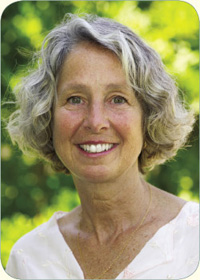 Shari Sunshine, LMT, is an acupuncturist, massage therapist, teacher, and meditator who has spent more than 35 years living, working, and teaching massage and bodywork. She is the co-founder of Ashland Massage Institute and Syntropy International. Recently, while visiting Nepal, Shari fell and hurt her back. This article is the product of her insight into the self-healing that she accomplished while recovering in bed for a month in a guesthouse in Kathmandu.
Shari Sunshine, LMT, is an acupuncturist, massage therapist, teacher, and meditator who has spent more than 35 years living, working, and teaching massage and bodywork. She is the co-founder of Ashland Massage Institute and Syntropy International. Recently, while visiting Nepal, Shari fell and hurt her back. This article is the product of her insight into the self-healing that she accomplished while recovering in bed for a month in a guesthouse in Kathmandu.
Chronic pain: When the habitual tendencies, even relatively new habits that were originally caused by recent injuries, resist change because of not knowing that a re-organization would be ultimately beneficial, less painful and provide graceful, more functional movement.
Chronic pain is the very same phenomena whether it occurs on the physical, emotional and/or mental levels. It is called ignorance in Buddhist terminology. It is simply a lack of the capacity to know or understand that the present pattern of movement, emotional state, mental evaluation is painful or causes suffering, and that a simple, or even a minute change in the ways the muscles move, or the mind evaluates, will alleviate the pain.
This change is brought about by first becoming aware of the habitual pattern by meeting it gently. What does this mean? It could mean becoming aware with the assistance of a massage therapist gently touching the area, softly massaging the area, slowly moving the area within its chronic capacity, or moving the area oneself in ways that show the body the limitations that have become habitual. Once the awareness is there, the body can begin to make choices. Questioning the necessity of the limitation is a key to knowing if the limiting conditioning can be released. At first, the body believes that letting go of the holding pattern will cause pain because in the past, when there was acute pain and inflammation, certain movements were painful. After the acute phase, the movements may be pleasurable, but the body only remembers the pain response and until shown otherwise, will hold onto the pattern it believes will not cause pain. Once shown that the movement, or the release is pleasurable, the body will enjoy the new possibility. Remembering the new possibility requires practice, just like releasing conditioned emotional patterns require practice, as do mental patterns. There is no difference in the process ultimately.
It is much easier to allow new changes in the physical, emotional and mental bodies when one has a basis of practice prior to an injury, an emotional upset or mental tension that might occur in stressful circumstances. Actually, I suppose the first step is to clear away, as much as possible, the habitual patterns that have already accumulated, like purification practices, yoga, movements, qi gung, or cleansing diets. Although these karmic tendencies are rarely completely eliminated, and must be constantly practiced, at least when situations occur after the purification practices, we are able to call upon our previous practice deliberately and in a timely manner to assist in the healing process when necessary. Without prior practice, the body/mind will automatically go into patterns that may be ultimately dysfunctional, harmful to the healing process.
There are many “spiritual practices” to be found. There are many disciplines that assist the body/mind. There are countless possibilities to be discovered right in your own neighborhood, or in the world at large. All of the practices are practices. That means that in order to benefit from them, we must do them over and over again, like training in any discipline. It may take years to come to a place of ease in certain yoga postures, and once that ease is discovered, one must keep practicing the asana in order to continue to benefit from the posture. If the practice ends, so does the benefit. This is also true of all “spiritual practices”. It is interesting to explore and discover which of the many thousand disciplines fit ones own personality. It is sometimes difficult to continue to practice a discipline for a long time. To benefit from any of these disciplines, one must continue to practice in order to really find the value of the practice when it is most needed, as in after an injury, an emotional upset or stressful situation.
With practice and opportunity to understand the possibilities, the body/mind will always choose the most functional option, the opportunity to move through life with openness, trust and clarity. Without having a practice, the body/mind will most likely continue to acquire dysfunctional tendencies that accumulate until there is chronic pain; mental, emotional or physical. When this happens, the learning process to eliminate the suffering requires unlimited patience and compassion. This is also beneficial.
Ultimately, the pain lacks existence once the light of awareness has been brought to the area and movement in a functional manner is realized/practiced. In other words, the actual (chronic) pain, suffering, is but a memory, which is no long relevant to the present moment. This is also true of all of the suffering that arises in the body/mind. It is true that the pain once existed, but it is not true that it must be maintained by conditioned response. Once this is realized, then there is only blissful awareness and joyful release of the conditioned response.

 For most of us, stress most frequently arises from how we are thinking, and less frequently from what is actually happening. In other words, most stress we experience is mental stress, not a physiological response to immanent physical danger. Mental stress arises when we worry about the future, despair about the past, want what we don’t have, and don’t want what we do have. Those are all thoughts not related to the present moment or circumstances. Massage therapy grounds a person into a safe, pleasant, present-moment experience where the causes of mental stress are much less likely to arise. When someone comes in to receive a massage, their future, for one hour, is one that promises to be filled with pleasure and mindfulness, their thoughts of the past are gradually overpowered by the pleasure and mindfulness of their present moment, and they so much enjoy what is happening to them that they are temporarily relieved of the stress of wanting what they don’t have. For that hour, the causes of a person’s mental stress are reduced, and thus they are given an opportunity to view their world from a new perspective. Massage therapy reminds a person: What is happening now is good. This perspective is the opposite of the stressed-out one that they came into the session with, and that change of perspective is the first step on the deeper path of true relaxation.
For most of us, stress most frequently arises from how we are thinking, and less frequently from what is actually happening. In other words, most stress we experience is mental stress, not a physiological response to immanent physical danger. Mental stress arises when we worry about the future, despair about the past, want what we don’t have, and don’t want what we do have. Those are all thoughts not related to the present moment or circumstances. Massage therapy grounds a person into a safe, pleasant, present-moment experience where the causes of mental stress are much less likely to arise. When someone comes in to receive a massage, their future, for one hour, is one that promises to be filled with pleasure and mindfulness, their thoughts of the past are gradually overpowered by the pleasure and mindfulness of their present moment, and they so much enjoy what is happening to them that they are temporarily relieved of the stress of wanting what they don’t have. For that hour, the causes of a person’s mental stress are reduced, and thus they are given an opportunity to view their world from a new perspective. Massage therapy reminds a person: What is happening now is good. This perspective is the opposite of the stressed-out one that they came into the session with, and that change of perspective is the first step on the deeper path of true relaxation.
